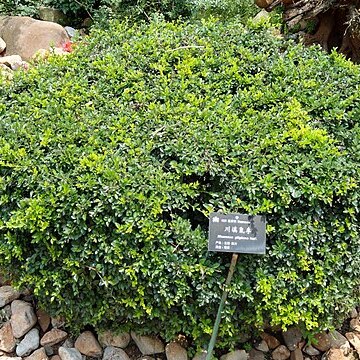Shrubs 1-2 m tall, much spinescent. Branchlets spreading, opposite, subopposite, or alternate, black-brown, gray when young, puberulent, terminating in a spine; old branches gray-brown or brown, glabrous, irregularly fissured. Leaves opposite or subopposite, rarely alternate, or fascicled at short shoots; stipules linear-subulate, shorter than petioles, caducous; petiole 1-3 mm, puberulent; leaf blade abaxially pale green, turning black when dry, adaxially dark green, elliptic or ovate-elliptic, rarely lanceolate or lanceolate-oblong, 1.5-3 cm × 5-10 mm, papery to thickly papery, abaxially clustered hairy in vein axils or subglabrous, lateral veins 3 or 4 pairs, nearly inconspicuous, base cuneate, margin often revolute, inconspicuously crenulate or subentire, apex obtuse or rounded, sometimes emarginate, rarely slightly acute. Flowers yellow-green, turning black when dry, unisexual, 4-merous, usually 3-5-fascicled in leaf axils of short shoots. Male flowers campanulate, 3.5-4 mm, sparsely puberulent; sepals ovate-triangular, 2-2.5 mm, apex acuminate; petals oblong-lanceolate, small, ca. 1 mm; stamens nearly equaling petals; rudimentary ovary minute; style 2-fid; pedicels 1-3 mm, puberulent. Drupe brown, subglobose, 4-5 mm in diam., with shallow, cup-shaped, persistent calyx tube at base, with 2 or 3 stones; fruiting pedicel 2-3 mm, glabrous. Seeds pale brown, elliptic, 4-4.5 mm, abaxially with a margined furrow extending over 4/5 of length. Fl. Apr-May, fr. Jun-Aug.
More
A shrub. It grows 1-2 m tall. It has spines. The leaves are opposite or in groups on short shoots. The leaves are pale green underneath. The leaves are narrowly oval and 2-3 cm long by 5-10 mm wide. The flowers are yellow-green. Male and female flowers are separate. The fruit is a flattened round shape and brown. It is 4-5 mm across.

